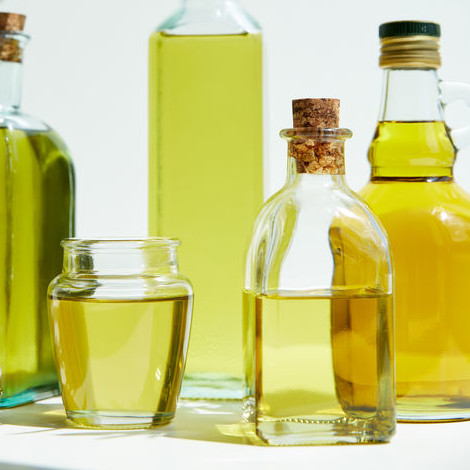
Oil
What is Oil?
Oil is a plant-derived fat that remains liquid at room temperature. It can be obtained from soybean, sunflower, corn, linseed, palm, coconut, rapeseed, olives, peanut, canola and many other plants.
Oils are made up of a mixture of triglycerides containing fatty acids of various lengths and composition. They are free from animal-cholesterol. Except those sourced from palm and coconut, oils are generally low in saturated fats and high in mono- and polyunsaturated fats.
Function
In baking, oils can help with:
- Texture improvement
- Moisture retention
- Flavor carriers
- Shelf life extension
- Lubrication
In baking, lubrication is of utmost importance for ease of dough handling and its expansion. In loaf breads, oil provides better slicing. Furthermore, it tenderizes baked items and helps in prolonging shelf life by slowing down retrogradation or staling.
Stability of cooking oils
Oil instability is a major concern and can result in loss of quality (rancidity) and nutritional value as well as safety concerns. Antioxidants are often added to oil-containing foods to prevent peroxidation.
Rancidity of oils is assessed by measuring the peroxide value (PV). The test measures the peroxide and hydroperoxide concentrations formed due to oil oxidation. Results are expressed as milliequivalents of peroxide oxygen that combines with 1 kg (meq/kg) of oil to liberate iodine from potassium iodide.1
The Codex Standard for Named Vegetable Oils (CODEX-STAN 2010 – 1999) specifies that peroxide values of vegetable oils should be less than 10 and 15 milliequivalents of active oxygen/kg oil for refined and cold pressed virgin oils respectively.
Types of oils, extraction processes, composition, applications and regulations:
| Type | Extraction/ Commercial Production | Composition | Uses | FDA Regulation |
| Olives | Stone milling | Oleic (64.8% and 72.8%), palmitic acid (11.34%-17.33%), linoleic acid (6.08% – 11.68%), stearic acid (1 %-2 %), palmitoleic acid (1-1.6%), linolenic acid (0.1 – 0.9%) and arachidic acid (0.3 %-0.9 %). | Salad dressings, marinades, butter/margarine dip, mayonnaise. | GRAS |
| Palm oil | Fruit sterilization, loosening/stripping, digestion, extraction, clarification, refining, bleaching, deodorization | 50:50 saturated: unsaturated fatty acids. | Cooking, margarine, bread dough, cookies, whipping cream, frying. | Palm kernel oil is GRAS regulated by FDA in article 21CFR172.861. |
| Coconut | Extraction through pressing of copra or dried coconut meat | 92% saturated fatty acids, 70% of them are medium chain fatty acids. | Baked goods, infant formula, chocolate applications, used trans-fat substitute. | GRAS |
| Soybean | Solvent extraction/ mechanical or hydraulic pressing | Rich in polyunsaturated fatty acids (PUFAs). | Used to produce lecithin and in baked goods. | GRAS.
Should be declared as an ingredient in shortenings and whether it is hydrogenated. |
| Corn | Extracted from the germ of the corn kernel | 52% linoleic acid , 31% oleic acid, 13% palmitic, 3% stearic and 1% linolenic acid and 14.8 % vitamin E per 100 grams. | Used in salads and as a cooking oil. | They do not need to comply with the total fat disqualifying level set forth by U.S. FDA. |
| Canola | Extracted using a solvent system from heated, crushed seeds2 | 7.4% saturated fatty acids, 61.8% oleic acids, 9.1% linolenic acid, 18.6% linoleic acid. | Perfect for making tender cakes, muffins, brownies, cookies, and quick breads. Used often in box mixes. | GRAS |
| Mineral | Distilled from crude petroleum | Mineral oil is chemically inert and is not absorbed by the body.3 | Lubricant, protects equipment from damage. | Permitted as a direct or indirect food additive for human consumption. In bakery products it is allowed as a release agent and lubricant not to exceed 0.15%. (21 C.F.R. § 172.878 2018). It is exempt from food labelling. |
| Sunflower | Extracted from the germ of the sunflower seed | 9.7 % saturated, 83.6% Monounsaturated, 3.8 % and Polyunsaturated fatty acids. | Used as frying oil, sunflower butter, salad dressings. | GRAS |
| Peanut | Extracted from peanuts | 17% saturated fats, 46% monounsaturated and 32% Polyunsaturated fatty acids. | Used for frying, adds a distinct taste.4 | GRAS
Highly refined peanut oil is exempt by the FDA from being labeled as an allergen.5 |
References
- AOCS Official Method Cd 8b-90 “Peroxide Value, Acetic Acid, Isooctane Method”, 2017 https://www.aocs.org/attain-lab-services/methods/methods/method-detail?productId=111547 Accessed on 5th April, 2019
- Gunstone, Frank D., ed. “Rapeseed and canola oil: production, processing, properties and uses”. CRC Press, 2004.
- FAO. FAO Nutrition Meetings Report Series No. 48A WHO/FOOD ADD/70.39.www.inchem.org/documents/jecfa/jecmono/v48aje08.htm. Accessed on 5 Jan. 2019.
- Liu, Xiaojun, Qingzhe Jin, Yuanfa Liu, Jianhua Huang, Xingguo Wang, Wenyue Mao, and Shanshan Wang. “Changes in volatile compounds of peanut oil during the roasting process for production of aromatic roasted peanut oil.” Journal of food science 76, (3) 2011 pp C404-C412.
- USDA FSIS, “ONGOING VERIFICATION OF PRODUCT FORMULATION AND LABELING TARGETING THE EIGHT MOST COMMON (“BIG 8”) FOOD ALLERGENS” 7320.1, Rev 2, 2018, pp. 10 https://www.fsis.usda.gov/wps/wcm/connect/dacf9504-f816-44fc-bd2e-9bbd1a0e2380/7230.1.pdf?MOD=AJPERES

